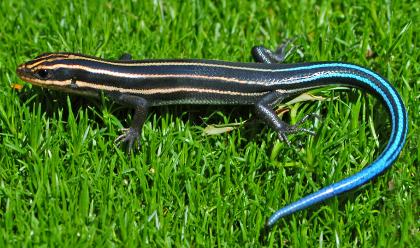


|
Scinidae:
The family Scincidae is the most species-rich lizard family with about 1200 species. Many species-rich genera (e.g. Sphenomorphus, Mabuya) are still studied insufficiently and their systematics is controversial.
Typically scincids are slighly to markedly elongate lizards that have relatively long-snouted and somewhat flattened skulls, in which the upper temporal opening is usually reduced or lost. The head is usually covered with enlarged plates, termed head shields, and osteoderms are frequently present in some or all scales. These osteoderms are unusual because each is composed of a set of smaller ones in contrast to a single bone as in other lizards. Smooth, shiny cycloid scales (few exceptions, e.g. members of the genus Tribolonotus). The partially to well-developed secondary palate is a distinctive feature of the skull. It is formed primarily by development of a novel lamina of the palatine bone on each side, which together essentially floor and prolong the choanal passage. In some species the palatal rami of the pterygoids extend the secondary palate posteriorly to about the level of the back of the tongue. Other osteological characteristics include paired premaxillae, descending processes from the parietals which meet the epipterygoids and an enlarged coronoid process of the dentary. The inner ear has an accessory inertial body, the culmen, which modulates hair cell sensitivity, and largely replaces the tectorial membrane, which is vestigial in skinks. Preanal and femoral pores are absent.
|
